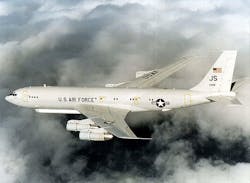Northrop Grumman Joint STARS performs test of JT-8D propulsion system
MELBOURNE, Fla., 24 May 2012. Northrop Grumman Corporation's (NYSE:NOC) E-8C Joint Surveillance Target Attack Radar System (Joint STARS) testbed aircraft, equipped with a new JT-8D propulsion system, has successfully completed flight testing and moved one step closer to receiving its Military Airworthiness Certification.
The completion of the flight testing program is a key component of the Military Airworthiness Certification process. The new propulsion system includes Pratt and Whitney JT-8D engines previously certified by the FAA for Boeing 707-300 aircraft, as well as mounting pylons and other provisions supplied by SevenQSeven and a pneumatic system to support the large ground surveillance radar and other mission equipment carried by the aircraft.
The Military Airworthiness Certification process consists of flight tests, data analysis and approval for the propulsion system to be used on aircraft that support worldwide operations out of Robins Air Force Base, Ga. JT-8D Propulsion System Military Airworthiness Certification enables the operational aircraft fleet to be outfitted with new engines, providing increased performance for equipped aircraft.
An enabling factor for the certification process was the execution of a risk mitigation program during the development and installation of the Propulsion Pod System. In total, 808 tests were completed, many of which were concurrent with other Joint STARS programs. The test program originally planned for 39 total flights, but the tests were all finished in 32 flights.
The Northrop Grumman E-8 Joint STARS aircraft is based off the Boeing 707-300 series commercial airliner. The E-8 features specialized radar, communications, operations and control subsystems. It features a radome under the fuselage that holds the side-looking APY-7 phased array antenna.
The first E-8C Joint STARS was delivered to the Air Force in 1996, and the last was delivered in 2005. The Joint STARS fleet is an all-weather, long-range, wide-area surveillance, battle management, and command and control weapons system. It combines wide-area moving target detection with radar imagery to locate, classify and track ground targets from standoff distances. Joint STARS offers battlefield commanders situational information, while transmitting target locations to aircraft and ground strike forces.
